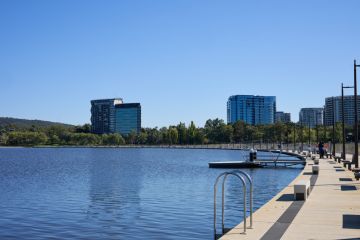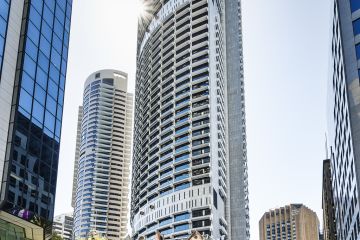How to make the most of your outdoor space with minimum effort

Half of Australian home owners have identified the backyard as an essential feature in a new home, according to a new home ownership report from Westpac.
But once you’ve snared that much-desired outdoor space, you then have to figure out what to do with it – other than sticking in a barbecue and hoping for the best.
For those of you without a green thumb in sight, here are six ways to maximise your outdoor assets with minimum effort.
1. Play with texture in the front yard
If you’re one of the lucky ones who have snagged a quintessential Australian terrace, don’t feel tied to the standard front lawn with a little bordering hedge, landscaper at Landart Landscapes and president of the LNA Master Landscapes Association Matt Leacy says.
“Removing a lawn and planting the whole thing will reduce your maintenance significantly, and reduce water usage,” Leacy says. It also means not mowing every two weeks in summer, which is handy for the time-poor and heat-averse.
Layering the plants helps make the space look bigger. For a more contemporary feel, Leacy suggests mixing different varieties of agaves and ornamental grasses to bring in greens, as well as introducing different colours such as silver.
“Different forms create the interest that keeps your eyes looking at different things,” which makes for a more pleasing outlook, Leacy says.
If you’d prefer the traditional look, some deciduous trees don’t use much water. For example an ornamental pear lets sun in during the winter and provides pretty foliage and flowers during the warmer months.
2. Concentrate on soft landscaping (and put money into the design)
In terms of the best returns for minimum effort, landscape architect and horticulturist Ben Scott advises that first-time garden owners are better off concentrating on soft landscaping.
This includes gardening such as planting, laying turf and improving the soil, and tasks like putting in a basic gravel or paved path.
“This is something that owners can undertake themselves,” Scott says.
Even when doing garden work yourself, you can hire a landscape designer to work on the initial concept for your backyard.
“Typically half the cost in construction is labour,” Scott says.
3. Take your inspiration from the ocean
Leacy suggests looking to the seaside, and particularly headlands, to get some inspiration for an easy garden. The plants you find there are “very hardy, very low maintenance”.
Choose little succulents mixed in with small shrubs or hedges that can be trimmed, such as a carpobrotus (pigface) with purple flowers, teamed with a native such as a tea tree.
“Then you can combine them with a few exotics and you get a really nice mix,” Leacy says.
4. Get into the garden now
Take advantage of that burst of spring enthusiasm and get out and weed and mulch your garden now – it’ll help keep moisture and coolness in the soil over summer.
“Pull all the weeds and put a thick mulch on – it will make your life a lot easier,” Leacy says.
Scott agrees: “Your plants grow in spring and summer – if you can get them into the ground now, that’s absolutely ideal.”
5. Grow your own (vegetables)
Don’t be afraid of making your garden earn its keep.
“I always think that if you’re growing something you’re going to eat, you’re more likely to think about it and nurture it,” Leacy says.
“Really easy things to grow are lettuces, baby spinach and rocket – you can pick it through the season too.”
Tomatoes are also easy to grow (assuming you don’t have possums) and are very rewarding; home-grown tomatoes taste a lot better than some of the ones you might buy at your local supermarket.
“The hotter and harsher the suns gets the more care you have to put in, but if you put them in now you should have tomatoes by December.”
6. A rose by any other name
If you’re not a confident gardener, floral plants such as roses might not be the decorative option for you.
“Those plants are pretty and people love them, but they often have the most amount of care and maintenance.”
Scott suggests focusing on drought-tolerant, high-performing plants, and steering clear of azaleas, hydrangeas and gardenias – flowering plants that require a lot of upkeep.
On the other hand, something that’s considered quite high-maintenance – the citrus – can work with the right set-up. The good varieties are fairly easy to grow anyway, Leacy says, but to maximise your chances try popping it in a large pot so that it’s contained but still moveable.
“People often plant them wrong – in a pot you can move it to the follow the sun, which is very handy. You can keep it in the sun all year around.”
7. Indoor bonus: Look past the fiddle-leaf fig
Don’t feel left out if you’re restricted to indoor plants – but one current design trend might be better avoided if you have black thumbs. “Fiddle leaf figs aren’t that straightforward,” Leacy says. “They need a bit of care and maintenance.”
He suggests instead something like mother-in-law’s tongue (sansevieria) is better if you don’t have strong sunlight. It’s an upright succulent which needs almost no care (just watch out for over-watering).
Alternatively there’s the peace lily (spathiphyllum). “They’re an oldie but a goodie. They’ll literally wilt and fall over when they need a drink. You water them, they pop back up and they are fine.”
The classic maidenhair fern, succulents such as the kalanchoe silver spoon or copper spoon, and kentia palms are also relatively easy indoor plants.
We recommend
We thought you might like
States
Capital Cities
Capital Cities - Rentals
Popular Areas
Allhomes
More
- © 2025, CoStar Group Inc.






